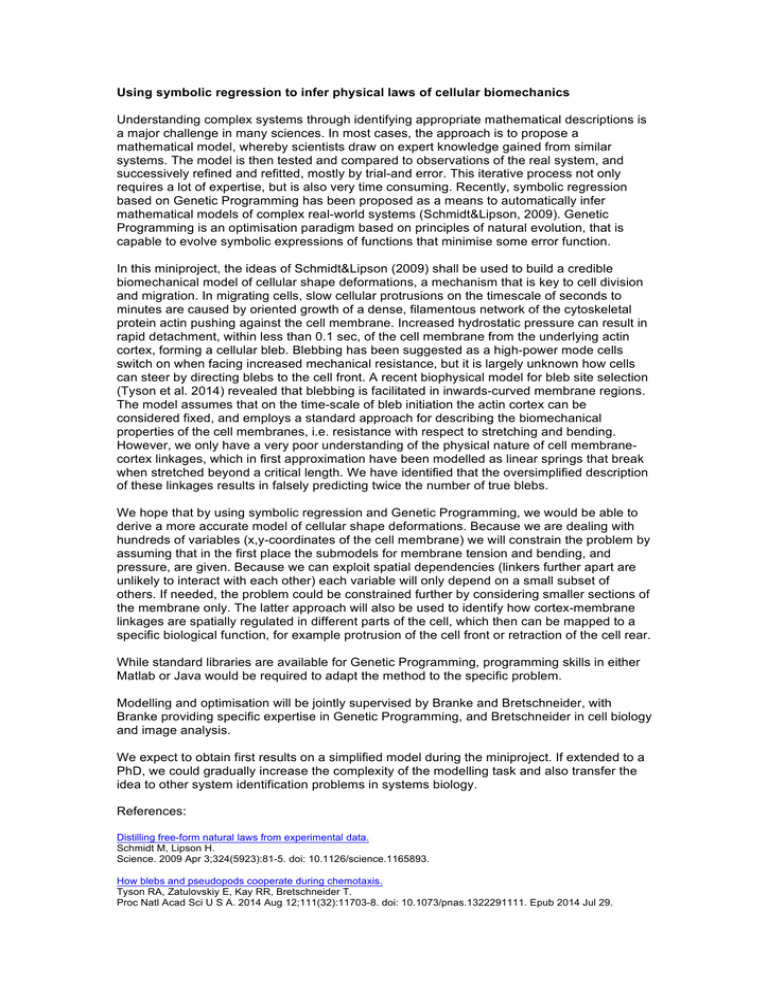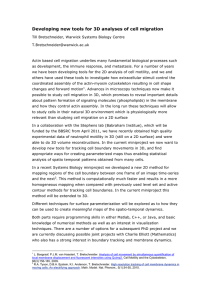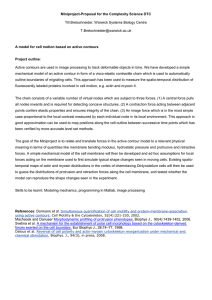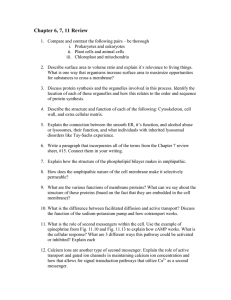Using symbolic regression to infer physical laws of cellular biomechanics
advertisement

Using symbolic regression to infer physical laws of cellular biomechanics Understanding complex systems through identifying appropriate mathematical descriptions is a major challenge in many sciences. In most cases, the approach is to propose a mathematical model, whereby scientists draw on expert knowledge gained from similar systems. The model is then tested and compared to observations of the real system, and successively refined and refitted, mostly by trial-and error. This iterative process not only requires a lot of expertise, but is also very time consuming. Recently, symbolic regression based on Genetic Programming has been proposed as a means to automatically infer mathematical models of complex real-world systems (Schmidt&Lipson, 2009). Genetic Programming is an optimisation paradigm based on principles of natural evolution, that is capable to evolve symbolic expressions of functions that minimise some error function. In this miniproject, the ideas of Schmidt&Lipson (2009) shall be used to build a credible biomechanical model of cellular shape deformations, a mechanism that is key to cell division and migration. In migrating cells, slow cellular protrusions on the timescale of seconds to minutes are caused by oriented growth of a dense, filamentous network of the cytoskeletal protein actin pushing against the cell membrane. Increased hydrostatic pressure can result in rapid detachment, within less than 0.1 sec, of the cell membrane from the underlying actin cortex, forming a cellular bleb. Blebbing has been suggested as a high-power mode cells switch on when facing increased mechanical resistance, but it is largely unknown how cells can steer by directing blebs to the cell front. A recent biophysical model for bleb site selection (Tyson et al. 2014) revealed that blebbing is facilitated in inwards-curved membrane regions. The model assumes that on the time-scale of bleb initiation the actin cortex can be considered fixed, and employs a standard approach for describing the biomechanical properties of the cell membranes, i.e. resistance with respect to stretching and bending. However, we only have a very poor understanding of the physical nature of cell membranecortex linkages, which in first approximation have been modelled as linear springs that break when stretched beyond a critical length. We have identified that the oversimplified description of these linkages results in falsely predicting twice the number of true blebs. We hope that by using symbolic regression and Genetic Programming, we would be able to derive a more accurate model of cellular shape deformations. Because we are dealing with hundreds of variables (x,y-coordinates of the cell membrane) we will constrain the problem by assuming that in the first place the submodels for membrane tension and bending, and pressure, are given. Because we can exploit spatial dependencies (linkers further apart are unlikely to interact with each other) each variable will only depend on a small subset of others. If needed, the problem could be constrained further by considering smaller sections of the membrane only. The latter approach will also be used to identify how cortex-membrane linkages are spatially regulated in different parts of the cell, which then can be mapped to a specific biological function, for example protrusion of the cell front or retraction of the cell rear. While standard libraries are available for Genetic Programming, programming skills in either Matlab or Java would be required to adapt the method to the specific problem. Modelling and optimisation will be jointly supervised by Branke and Bretschneider, with Branke providing specific expertise in Genetic Programming, and Bretschneider in cell biology and image analysis. We expect to obtain first results on a simplified model during the miniproject. If extended to a PhD, we could gradually increase the complexity of the modelling task and also transfer the idea to other system identification problems in systems biology. References: Distilling free-form natural laws from experimental data. Schmidt M, Lipson H. Science. 2009 Apr 3;324(5923):81-5. doi: 10.1126/science.1165893. How blebs and pseudopods cooperate during chemotaxis. Tyson RA, Zatulovskiy E, Kay RR, Bretschneider T. Proc Natl Acad Sci U S A. 2014 Aug 12;111(32):11703-8. doi: 10.1073/pnas.1322291111. Epub 2014 Jul 29.










